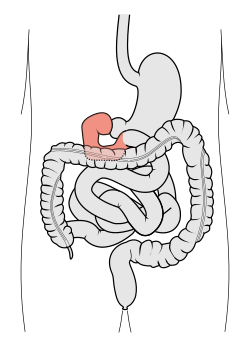| Duodenitis | |
|---|---|
 | |
| Duodenum(marked) | |
| Specialty | Gastroenterology |
Duodenitis is inflammation of the duodenum. It may persist acutely or chronically. [1]
| Duodenitis | |
|---|---|
 | |
| Duodenum(marked) | |
| Specialty | Gastroenterology |
Duodenitis is inflammation of the duodenum. It may persist acutely or chronically. [1]
Known symptoms of duodenitis include:
Known causes of duodenitis include: [2]
Diagnosis is generally made by endoscopy with biopsy to evaluate histology. Review of symptoms and associated conditions is important.
Treatment is aimed at removing the irritant or infection. Helicobacter pylori infection is usually treated with antibiotics.